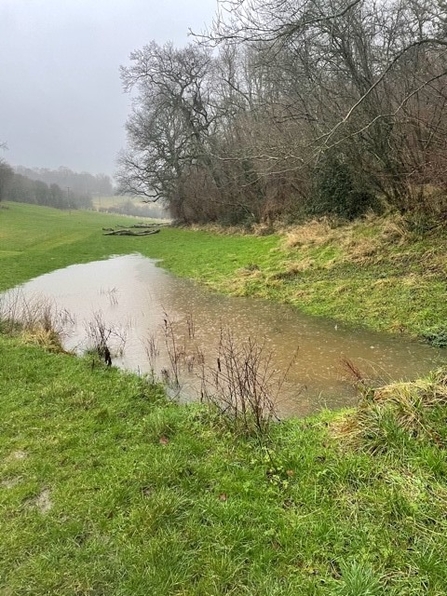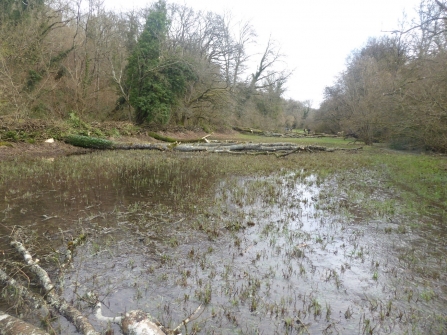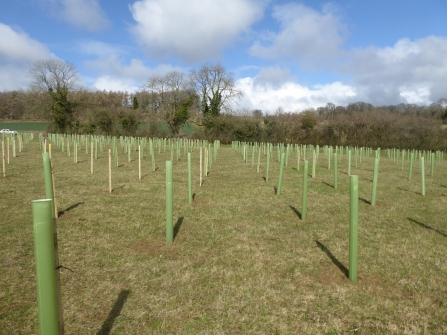Whilst flooding is a natural process, climatic change is causing storm events to become more intense with the total rainfall in the UK set to increase during winter. In order to better manage flood risk and reduce the devastation flood events can cause to communities, homes and infrastructure, it is important to recognise the factors that contribute to increased flood risk in towns and villages.
Poor land management practices can exacerbate flooding. When soils are compacted, they lose their capacity to store water and when rivers are straightened and dredged, they move water more quickly through a catchment and downstream towards towns and villages. When natural floodplains have been built or developed on, water has nowhere else to go and causes properties to flood. Wetlands and natural floodplains are important areas for water storage but also provide habitats for an array of plants and wildlife.
Natural Flood Management
Natural Flood Management (NFM) is an approach that seeks to store flood water and ‘slow the flow’ of water reaching the river channel by altering or restoring the landscape. NFM techniques provide enhanced water storage during a storm event, through using natural materials to engineer structures that temporarily hold rainwater in the headwaters. The creation of bunds and ponds with extra capacity provides temporary storage and helps to reduce the speed and the peak flow going downstream. After the storm event, water can then drain away slowly.

Earth bunds store water following heavy rainfall
Another method to increase water storage is creating a series of large woody debris dams or leaky dams that are installed across the water course or pathways of runoff. These structures are an effective method of sustainable flood alleviation as they help attenuate flood flows by slowing and deflecting flow out of the channel and onto the floodplain. Woody material in watercourses increases flow variability, with faster flowing water cleaning gravels which is important for spawning fish.
With careful design and planning, soft engineered structures can have minimal impact on current land use whilst offering a sustainable, cost effective solution to mitigate flooding in addition to storing carbon and providing habitat opportunities for wildlife.
Leaky dams help attenuate flood flows by slowing and deflecting flow out of the channel
Increasing Floodplain Roughness
A significant way to delay the progression of flood flows through a catchment is the presence of riparian and floodplain woodland. Floodplain woodland not only provides storage and helps alleviate flooding but it also benefits water quality and freshwater habitats that are important for nature conservation, fisheries and landscape restoration.
Planting floodplain woodland will help increase the resilience of communities that are threatened by flooding, especially where it is not cost-effective to construct engineered defences. Whilst most of Britain’s floodplain woodland has been lost due to land reclamation works and past river engineering, many organisations are working to promote its restoration. In order to implement a whole-catchment approach to sustainable flood management, it is important to recognise that woodland must be integrated with agriculture and other land uses within a landscape.
Trees and deadwood in the floodplain help slow the peak flow of a river, reducing the risk of flooding
The presence of woody debris dams within river channels along with the presence of trees, shrubs and deadwood on the floodplain results in an overall smaller downstream flood event. The combination of these features increases hydraulic roughness (the resistance of a bed or floodplain to the flow of water) which can substantially alleviate flooding through slowing down flood flows by enhancing out of bank flows and reducing flood velocities as well as increasing water storage on the floodplain.
The hydraulic impact of large woody debris within a channel and on floodplain includes:
- Increased water storage, delaying and reducing flood flows
- Reduction in water velocity along water course
- Promotion of habitat creation with increased variability of flows
- Increased water depth upstream of dams promoting overbank flows onto floodplain
- Scour and trap mobilised silt and sediment

Deadwood on the floodplain results in an overall smaller downstream flood event
Tree management and planting
Planting new trees and the improved management of existing riparian and floodplain woodlands can have a beneficial effect on flood alleviation. Woods and trees on floodplains can help mitigate the effects of large floods by enhancing flood storage through absorbing and delaying the release of flood flows. Where suitable in a catchment, planting a small woodland or hedgerow across steep slopes or along streams and rivers, can significantly reduce the volume of water reaching the river channel.
Carefully sited woods and trees can intercept water flowing off the hillside, helping to phase the release of water during peak flows by slowing the speed at which water enters a river and moves downstream. Appropriately sited trees and woodland along sediment and run-off pathways can interrupt flow routes and increase soil infiltration, reducing flooding and the amount of sediment reaching a river channel. Trees and hedgerows can act as a buffer that reduces the amount of pollutants, nutrients and sediment reaching a watercourse.
Although riparian woodland has declined in many areas, native trees and woods have a key role to play in water management. With a changing climate it is important to put the right trees in the right places and think about how new trees can connect to the wider landscape. In March 2020 we planted over 1100 trees as part of a bigger planting scheme and natural flood management project to link to a protected area of woodland (SSSI) in Puckham reduce flooding to Andoversford.
Improved management of existing riparian woodlands and new planting will also have other beneficial effects, including:
- Provide habitats and food sources for wildlife leading to increased biodiversity and the restoration of native ecosystems
- Cleaner air as trees capture atmospheric pollutants at source
- Improved water quality by reducing pollutants and nutrients from reaching a watercourse
- Reduced soil erosion as tree roots help bind soil and protect river banks
- Better connected landscape
- Cost-effective method of flood control for small, rural communities where large, hard-engineered projects are too expensive

Targeted woodland can delay flood flows, reducing downstream flood risk
Restoring rivers to their natural course
Rivers naturally meander along their floodplains but unfortunately the physical structure of many river channels have been modified and straightened to benefit society for example through generating power and improving navigation. However, these changes that prevent river systems from behaving naturally can accelerate flow and increase flooding downstream. Furthermore, man made changes to a natural watercourse often lead to long term ecological damage to a river system, its hydrology and wildlife associated with a riparian habitat. Work to restore rivers to their natural floodplains and wetlands has a natural slowing and filtering effect on water, whilst also depositing gravels in areas that won’t cause damage therefore reducing the need and cost of river maintenance.
A river that naturally meanders:
- Improves water quality
- Can reduce flood risk
- Has better exchange with groundwater
- Flood flows are slowed
- Flood peaks are delayed, which gives people more time to prepare
A natural meandering river

